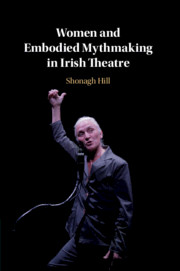Book contents
- Women and Embodied Mythmaking in Irish Theatre
- Women and Embodied Mythmaking in Irish Theatre
- Copyright page
- Dedication
- Contents
- Acknowledgements
- Introduction: A Creative Female Corporeality
- Chapter 1 Revolutionary Bodies: Mythmaking and Irish Feminisms
- Chapter 2 Unhomely Bodies: Transforming Space
- Chapter 3 Metamorphic ‘Bodies That Matter’: Process and Resistance
- Chapter 4 Staging Female Death: Sacrificial and Dying Bodies
- Chapter 5 Haunted Bodies and Violent Pasts
- Chapter 6 Olwen Fouéré’s Corpus: The Performer’s Body and Her Body of Work
- Bibliography
- Index
Chapter 1 - Revolutionary Bodies: Mythmaking and Irish Feminisms
Published online by Cambridge University Press: 29 August 2019
- Women and Embodied Mythmaking in Irish Theatre
- Women and Embodied Mythmaking in Irish Theatre
- Copyright page
- Dedication
- Contents
- Acknowledgements
- Introduction: A Creative Female Corporeality
- Chapter 1 Revolutionary Bodies: Mythmaking and Irish Feminisms
- Chapter 2 Unhomely Bodies: Transforming Space
- Chapter 3 Metamorphic ‘Bodies That Matter’: Process and Resistance
- Chapter 4 Staging Female Death: Sacrificial and Dying Bodies
- Chapter 5 Haunted Bodies and Violent Pasts
- Chapter 6 Olwen Fouéré’s Corpus: The Performer’s Body and Her Body of Work
- Bibliography
- Index
Summary
This chapter is concerned with the plays and tableaux vivants authored, and performed, by women at the turn of the twentieth century. Irish myth was identified as a source for the creation of a national theatre, and the cultural bedrock for an independent nation, but it was also a source for women’s activism and theatrical work. Through comparison of nationalist feminist performances: the tableaux vivants performed by the Inghinidhe na hÉireann in 1901; Maud Gonne’s performance in Kathleen ni Houlihan in 1902; and Gonne’s play Dawn (published 1904), with the pacifist feminism of Eva Gore-Booth’s play The Triumph of Maeve (published 1905), we can see how women’s diverse approaches to mythmaking and theatrical form provide a revealing study in the challenges that feminist politics faced in Ireland in the early twentieth century. Intervening in and exploiting the contradictions and tensions which animated this period of political ferment allowed these women to utilize myth to facilitate their self-authorship and to assert the creativity of female bodies; a revolutionary action which engaged with the rise of the woman-nation figure and countered disembodied icons of femininity.
- Type
- Chapter
- Information
- Women and Embodied Mythmaking in Irish Theatre , pp. 26 - 64Publisher: Cambridge University PressPrint publication year: 2019

